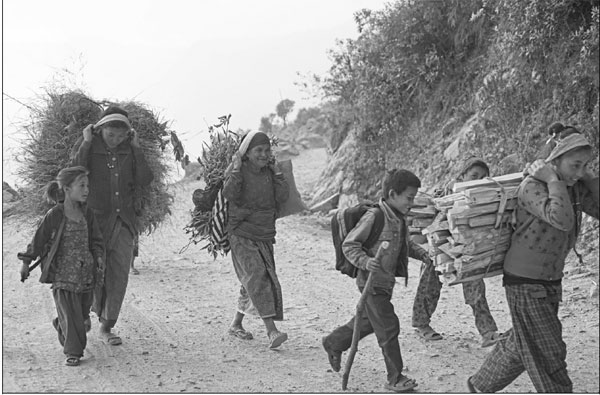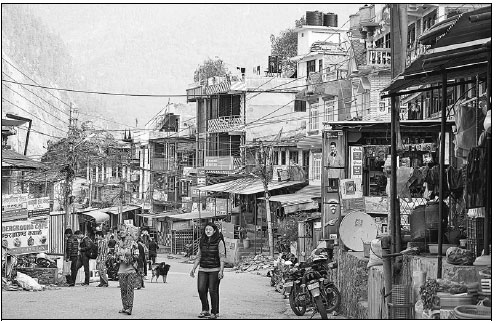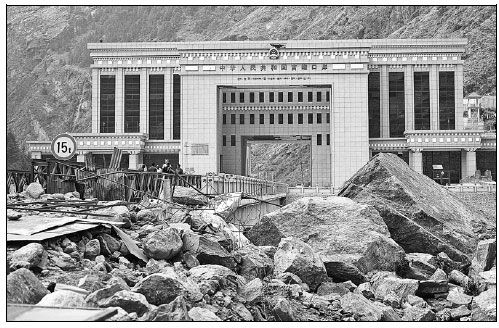Trading on a firm friendship
Updated: 2016-04-26 07:59
By Sylvia Chang(China Daily)
|
||||||||
Growing commercial links with China are helping the Nepalese government rebuild its economy after the country was devastated by an earthquake a year ago. Sylvia Chang reports from Rasuwa, Nepal.
The route from Nepal's capital city of Kathmandu to the Kerung border crossing, linking China, is about 150 kilometers. Bumpy and rocky, the road that snakes its way along the folded peaks of the Himalayas is now the only land-based lifeline between Nepal and its giant neighbor to the north.
The border crossing in Rasuwa district connects Nepal with Jilong county in the Tibet autonomous region. The route reopened in October, six months after it was closed after the devastating magnitude-7.8 earthquake that struck the country on April 25 last year. It is estimated that more than 8,000 people were killed and more than 21,000 injured in the quake and a series of strong aftershocks that followed.
The two other international border crossings in northern Nepal were also damaged.
Before the quake, the Khasa border crossing - 115 km from Kathmandu, and linking Kodari in Nepal with Zhangmu in China - was the major trading point between the two countries. Equipped with customs checkpoints and quarantine facilities, the crossing accounted for most of Nepal's trade with China.
Although the Kerung border point is not equipped with the same facilities, government officials in both countries attach great importance to the crossing. All the construction work indicates the facilities are being expanded, suggesting that the crossing is expected to thrive - not only as a bilateral trade route, but also as China's international access point to South Asia.
With its contrasting views of deep, winding ravines and imposing Himalayan peaks, the scenery along the road to Dhunche, the administrative headquarters of Rasuwa district, is spectacular.
Small, wooden houses perch high on the mountains, mostly in complete isolation. Clusters of villagers, wearing embroidered linen clothes, can occasionally be seen walking along the road. They carry grass-filled bamboo baskets on their backs. A herd of goats or yaks tags along, accompanied by the sound of clanging bells.
Living conditions may be primitive, but the lives linked by the border road look set to benefit from a change in attitude toward border policies between the two neighbors.
Business activity around the border crossing is picking up. A few months ago, 35-year-old Bisnu Maya Ghale opened a stall to sell snacks on the roadside, encouraged by the steady flow of Nepalese army personnel, police and laborers.
As a Rasuwa resident, Ghale has permission to pass through the border to conduct business in Jilong. She said her family plans to take out a bank loan to buy a truck to help them with their business.
"With the truck, my husband won't have to work overseas," she said, pouring milk tea for her two little daughters who were clinging to her legs.
Maintenance agreement
About 15 km from Dhunche is the small town of Syaphrubesi. The road stretches to Rasuwagadhi, a border town in Nepal that neighbors Jilong.
This 17-km section of the road was built by the Chinese government in 2012 as part of a $20 million grant, and both countries plan to extend the road and build more facilities.
Wu Chuntai, the Chinese ambassador to Nepal, has taken steps to implement a maintenance project for the Syaphrubesi-Rasuwagadhi highway. The move came after Wu accompanied Nepal's Prime Minister Khadga Prasad Sharma Oli to China in March.
Kedar Prasad Paneru, head of the Rasuwa customs office, said a technical team from China has finished surveying the land around the Timure customs office in Rasuwa, where a "dry port" will be established for freight traffic and customs clearance services.
"The two parties are discussing land acquisition. Upon completion, the dry port will cover 4 hectares of land in the Langtang National Park," Paneru said.
On the Nepalese side, officials plan to build a customs house on the same scale as the one on the Chinese side, according to a senior Nepalese government official.
Not far from a makeshift customs house, stand the Chinese joint inspection buildings - one for immigration purposes and another for customs services.
In a reclaimed valley a few meters below the customs office, Indian trucks are parked in an area that can accommodate 200 vehicles. The trucks are loaded with noodles, cookies and herbs from Nepal, and electronics goods, aluminum products and ready-made garments from China.
Statistics provided by the Rasuwa customs office show that during the first nine months of the fiscal year, customs duties worth 1,050 million Nepalese rupees ($9.9 million) were collected at the crossing point. The sum is far higher than the full-year target of 390 million rupees.
Chief customs officer Paneru said a border facility that is currently under construction will ease clearance congestion at the customs point, and the Chinese government is determined to make the border point an international trade hub for South Asian countries.
Last year, the trade volume at the border with Jilong reached 612 million yuan ($95 million), and commodities transported from Jilong to Nepal rose seven times compared with 2014, according to statistics from the Chinese embassy in Nepal.
The Kerung border is booming, not just in terms of trade, but also tourism. Chinese tourists are now allowed to travel to Nepal through the checkpoint.
On a typical early morning in April, a number of Chinese cars arrived at the border's immigration center. Droves of Chinese tourists streamed out and squeezed into an upstairs office no larger than 10 square meters.
On average, about 60 Chinese tourists travel to Nepal through this border every day. By April 12, the immigration office had issued 4,829 visas on arrival for Chinese people.
A cross-border railway is scheduled to be built by 2020, running from the Tibetan city of Xigaze to the Nepalese border, as agreed by both countries during Oli's visit to Beijing in March.
By that time, the number of Chinese tourists visiting Nepal is expected to hit 300,000 a year - double the current number of 115,000, said Hari Prasad Bashyal, Nepal's former consul general to Lhasa.
Bashyal traced the origin of links between the two neighbors to the early 600s, when Bhrikuti, a princess of the Licchavi kingdom in Nepal, married Songtsan Gampo, Tibet's first emperor.
"This romance started a new chapter in history," said Bashyal, anticipating a thriving trans-Himalayan relationship in the future.
Santa Gaha Magar contributed to this story.
Contact the writer at sylvia@chinadailyhk.com
China continues to provide post-quake assistance
By April 20, the China Foundation for Poverty Alleviation, an NGO with links to the State Council, China's Cabinet, had raised 10.62 million yuan ($1.63 million) to assist Nepalese citizens who lost their homes and livelihoods during the magnitude-7.8 earthquake last year.
In the weeks immediately after the disaster, the NGO donated 4.48 million yuan to the emergency rescue services, while a further 1.96 million yuan was used to provide temporary shelters, and 4.17 million yuan was earmarked for reconstruction projects. Nearly 177,500 people will benefit from the donations.
To better carry out reconstruction work, the foundation signed an agreement with the Social Welfare Council of Nepal, and on Aug 13, it set up an office in the capital, Kathmandu, to oversee donations and projects.
On Sunday, a foundation stone was laid at a ceremony in Kathmandu to mark the start of reconstruction work at the Yuba Sahabhagita public school, which was destroyed by the tremblor. The reconstruction efforts will help more than 2,000 students.
Moreover, about 2.7 million yuan will be donated to public schools to help pay for reconstruction of buildings, to provide educational materials and to fund psychological support programs, according to Wang Xingzui, the NGO's vice-president.
For the next two years, the foundation will focus on the fields of education and sanitation to further assist with the reconstruction efforts, Wang said.
Chinese-backed projects face Himalayan task
With thousands of rivers surging through the Himalayas, Nepal has ample natural resources for the generation of hydropower. The country has the potential to produce 43,000 megawatts, but at present only 650 mW can be supplied at peak hours, less than half of the required 1,550 mW, according to statistics from the Nepal Electricity Authority.
China is already an investor in Nepal's hydropower industry, said Sher Singh Bhat, the authority's deputy managing director.
According to the authority's statistics, the first Chinese-invested hydropower project with a generation capacity of 50 mW will begin operations this year. Two Chinese-invested projects with a combined generation capacity of 20 mW are already in operation, and four other projects with a total capacity of about 85 mW are under construction.
For the Nepalese, darkness is an old friend. Even in the capital city of Kathmandu the electricity supply is cut for 12 hours a day. In the dry season, usually October to June, the country faces daily power shutdowns of up to 16 hours.
However, just as it is technically difficult to tap hydropower from the torrents rushing down between the cliffs, engineers and investors face many challenges, ranging from harsh conditions to disruptions by the local community and reams of red tape.
The devastating earthquake that struck Nepal on April 25 last year also damaged a number of hydropower projects under construction.
"We resumed work in September, but progress is very slow," said Li Haiyuan, project manager of the Rasuwagadhi hydroelectric project, which is being built by the China International Water and Electric Corp, a subsidiary of the State-owned China Three Gorges Corp.
The 111-mW project is located 5 kilometers from the Rasuwa border crossing between China and Nepal. Because the project was just 67 km from the epicenter of the quake, it suffered severe damage. Two workers from Li's team lost their lives, and the project suffered a loss of 100 million yuan ($15 mill-ion).
The Upper Tamakoshi Hydroelectric Project is located in Dolakha district, which also sustained severe damage. With the capacity to generate 456 mW, and with construction managed by Sinohydro Corp, a subsidiary of the State-owned Sinohydro Group, it is the largest under-construction project in Nepal.
"The road collapsed, transmission lines were slashed and the dam was flooded. The project has been delayed for at least two years," said Wang Gaobo, general manager of Sinohydro.
Rajesh Kazi Shrestha, president of the Nepal-China Chamber of Commerce and Industry, said it has been hard to attract large-scale Chinese projects to the country, despite the tremendous need for infrastructure investment.
Some of the challenges faced by potential investors include land acquisition and demands from affected communities, he said, adding that political wrangling in Nepal had also deterred many investors.
Complicated formalities and rules were among the other causes of uncertainty for many big projects.
Li, from China International Water and Electric, said the company's first investment in Nepal, the 25 mW Upper Madi Hydroelectric Project, was made "to test the waters", but the prolonged construction period resulted in the company making additional investment in the project.
SANTA GAHA MAGAR CONTRIBUTED TO THIS STORY.
|
Nepalese villagers carry bamboo baskets of grass along a road near Nepal's border with China. Sylvia Chang / China Daily |
|
Dhunche town, the administrative headquarters of Rasuwa district, Nepal. Sylvia Chang / China Daily |
|
China’s customs and immigration building at the Jilong border. SSylvia Chang / China Daily |
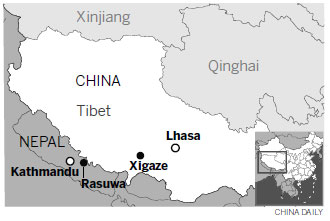
(China Daily 04/26/2016 page5)
- EU pledges 20 mln euros to nuclear safety fund
- DPRK seems set to launch Musudan ballistic missile
- Austria far right freezes out coalition in presidency race
- Chernobyl's 30th anniversary: Living under radiation
- S. Korea denounces DPRK's missile test
- Saudi-led coalition says kills more than 800 al-Qaida militants in Yemen

 30th anniversary of the Chernobyl nuclear disaster marked
30th anniversary of the Chernobyl nuclear disaster marked
 Shanghai unveils Disney-themed plane and station
Shanghai unveils Disney-themed plane and station
 Hebei's poverty-stricken village gets new look after Xi's visit
Hebei's poverty-stricken village gets new look after Xi's visit
 Cooks get creative with spring food exhibition in central China
Cooks get creative with spring food exhibition in central China
 The world in photos: April 18- April 24
The world in photos: April 18- April 24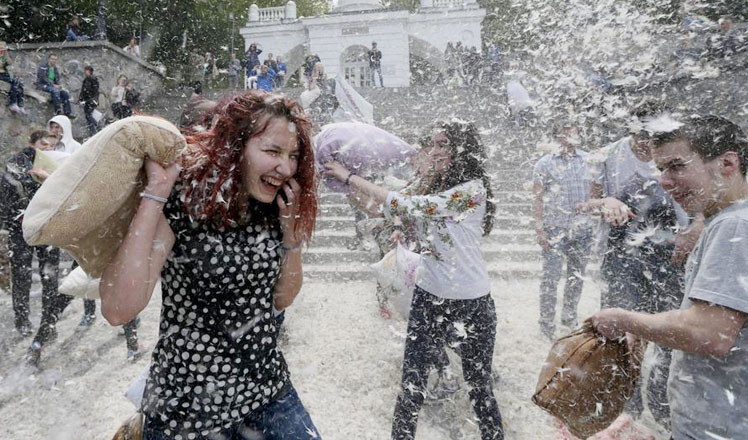
 People have fun in pillow fight held in Kiev
People have fun in pillow fight held in Kiev
 Laotian wives in East China's Anhui province
Laotian wives in East China's Anhui province
 Couples get married in their 'birthday suit'
Couples get married in their 'birthday suit'
Most Viewed
Editor's Picks

|

|

|

|

|

|
Today's Top News
Liang avoids jail in shooting death
China's finance minister addresses ratings downgrade
Duke alumni visit Chinese Embassy
Marriott unlikely to top Anbang offer for Starwood: Observers
Chinese biopharma debuts on Nasdaq
What ends Jeb Bush's White House hopes
Investigation for Nicolas's campaign
Will US-ASEAN meeting be good for region?
US Weekly

|

|
